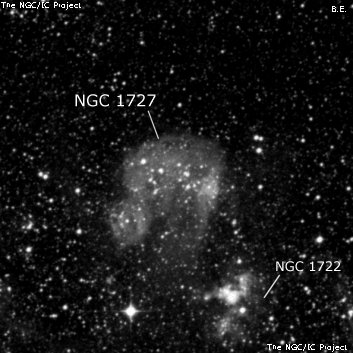
James Dunlop possibly discovered NGC 1727 = D 113 in 1826 with his 9" reflector and described "a small faint nebula; 12" or 15" diameter." He made a single observation and his position is 19' SSE of this nebulous cluster. Because of the poor match in position and simple description, this identification is very uncertain. JH made three observations of h2690 beginning on 3 Nov 1834, when he noted "a rather poor irreg R cluster. (Sky Hazy)". On a second sweep he recorded "A cluster, pB, pmE, 3' l, 90" br; stars 12m" His last description says "The third of a series of clustering patches. Oval." Herschel did not reference Dunlop's possible earlier observation.
400/500mm - 18" (7/10/05 - Magellan Observatory, Australia): fairly bright, fairly large, irregular patch, ~2.5'x1.5', with at least a half-dozen mag 13 stars resolved. This LMC cluster with nebulosity (N79E) responded well to a UHC filter at 128x. The western section is catalogued as LMC-N79C. A small extension was visible to the southeast consisting of cluster KMHK 187 (no stars were resolved) and LMC-N79D, increasing the size to ~3.5'x1.5'. NGC 1727 is in a group with NGC 1722 4' SW and NGC 1712 7.5' SW. Located 4' N of mag 8.5 HD 31722. This is a very young cluster or association (LH 2) with an unevolved main sequence similar to nearby NGC 1722.
18" (7/9/02 - Magellan Observatory, Australia): at 128x and UHC filter this is a fairly large elongated patch of nebulosity, ~3.5' diameter with a group of mag 12-13 stars superimposed. A smaller detached piece of nebulous haze, ~1' diameter, is close southeast. This is the 3rd (and 4th) in a chain of objects with NGC 1722 4.5' SW and NGC 1712 8' SW. A mag 8.5 star (HD 31722) is 4' SSE.
Notes by Steve Gottlieb